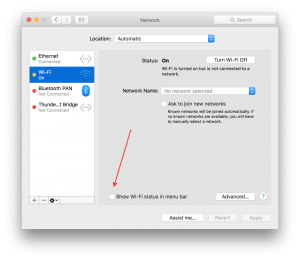Configuring Mac OS X for LSSA-ADMIN Image
Tested with OS 10.8.5 and 10.10.5
1. Installing Mac OS:
Use Diskmaker X to Create USB installer for OS version you wish to install.
Boot from the usb thumbdrive
Create single partition
Install OS
Create lssacsc user account at welcome screen
2. Create “default” user account
3. Login as default
4. Install OS updates
Copy \\jahvid\installs\Macintosh\Image utilities\munki-pkg-projects-master\Outset_OL_HideUTDIsland\payload\usr\local\outset\”login-once” folder to /usr/local/outset/
6. Open Safari and set www.ucla.edu as home page. make google default search
7. Install Chrome and firefox and set www.ucla.edu as home page. Make Google default search engine. Pin to Dock
8. Install and configure Software and any updates. It is important to run each program under the profile account. This will skip many of the annoying first-run prompts.
9. Pin Apps to Dock
10. Configure Finder Preferences and System Preferences. See LSSA Mac Finder Preferences and View menu Options – 10.11 (El Capitan) and LSSA Mac Setup System Preferences – 10.11 (El Capitan) on wordpress site https://sites.lifesci.ucla.edu/lssa-it/wp-admin/post.php?post=144&action=edit
11. Profile Cleanup
While logged in as default
Go to server a select forget recent servers and delete jahvid from the server field
Run Keychain Access (Applications/Utilities), select “login” and delete the keychain (right click > Delete keychain “login”).
Clear file histories (Apple menu -> Recent Items -> Clear Menu).
Empty trash
Shell Scripting Tasks
Log in as lssacsc
Open terminal and run the following command:
#Delete Swapfiles
rm /private/var/vm/swapfile*
rm -Rvf /Users/default/Library/Caches/
#Clean Up Global Caches and Temp Data
rm -rf /Library/Caches/*
rm -rf /System/Library/Caches/*
rm -rf /Users/Shared/*
rm -f /private/etc/ssh_host*
#Cleanup Root Home Dir
rm -rf /private/var/root/Desktop/*
rm -rf /private/var/root/Documents/*
rm -rf /private/var/root/Downloads/*
rm -rf /private/var/root/Library/Caches/*
rm -rf /private/var/root/Library/Recent\ Servers/*
rm -rf /private/var/root/Library/Logs/*
rm -rf /private/var/root/Library/Keychains/*
rm -rf /private/var/root/Library/Preferences/ByHost/*
rm -f /private/var/root/Library/Preferences/com.apple.recentitems.plist
rm -rf /private/var/root/Public/Drop\ Box/*
12. Make “default” User profile the template for future accounts
Restart the computer and log in as lssacsc.
Make a copy of the system wide default account
cp -R /System/Library/User\ Template/English.lproj/ /System/Library/User\ Template/English.orig/
Clear out the existing system-wide default account:
rm -rf /System/Library/User\ Template/English.lproj/*
Copy your new default account to the system default account:
cp -R /Users/default/ /System/Library/User\ Template/English.lproj
NOTE: At this point, you’ve now got the start of a system-wide default user profile – this is what gets used every time a new user is created on the system, including the first user when you go through the Apple Welcome process on a new computer.
Type “exit” to get out of the root shell and then close Terminal and reboot the computer.
Log in again as lssacsc.
13. System Cleanup:
Run Disk Utility (Applications/Utilities), select the hard drive and, under the First Aid tab, run “Repair Disk Permissions“. If you got things right to this point you’ll see a whole stack of information where this fixes permissions for the system-wide default user profile you’ve just copied. If you miss this step, permissions issues may get in the way when you create a new user later. Once you’re done, close Disk Utility.
14. To hide lssacsc account and default user account:
Login as “uid” account
Remove default user from administrators group
Open terminal and run the following command:
sudo defaults write /Library/Preferences/com.apple.loginwindow Hide500Users -bool YES
Ensure that the “Others” option will appear at the login window – in case the Login Options is still set to “List of users” (So that we can still get to the name and password login boxes). Open terminal and run the following command:
sudo defaults write /Library/Preferences/com.apple.loginwindow SHOWOTHERUSERS_MANAGED -bool TRUE
From System Preferences – Users and groups Change the “User ID” for each account to something in the 400-range eg… from 501 to 401
Turn off Hide500Users using: Open terminal and run the following command:
sudo defaults write /Library/Preferences/com.apple.loginwindow Hide500Users -bool NO
– This can be done under the hidden account itself.
15. Fix owner permissions for lssacsc home directory after changing the UID: open terminal and run the following command:
chown –R lssacsc /Users/lssacsc
14. Create Your Disk Image:
Restart the mac and hold down the “n” key to netboot
Login in to K2000 Admin using lssacsc password.
Select K2000 Imaging Utility on Dock
Fill in Image name (eg.. Mac OS X 10.10.5 Yosemite 12-2-15)
Select volume
Select Capture Apply ASR Format Images
Previous instruction – add to above instructions


